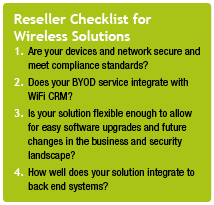
The term BYOD seems to have been plastered just about everywhere and although people now understand what it is the ramifications and required enablement for BYOD is often less understood. The structure of our IT networks are changing and taking us into a new wireless world of rapid and unpredictable developments, with ongoing operational and security challenges. David Dungay investigates.
When you take a look around the office these days it wouldn’t be surprising to see people using one, two or more wireless devices. They are an essential part of business life and I suspect at this time of year Christmas gifts will be responsible for an unprecedented strain on many a wireless network. Rene Hendrikse, Vice President EMEA at iPass commented “Because mobile working has become ingrained in the fabric of many businesses, there is a growing demand for resellers to provide them with a means to connect to the workplace from wherever they are in the world. Free publicly available networks are insecure and slow while the pay-for-play Wi-Fi options that are typically found in hotels and airports are too costly for regular use and result in hard-to-track billing for businesses. Equally, cellular services are insufficient for using bandwidth-hungry applications and performing critical tasks, such as videoconferencing, when on the move. And using them abroad also presents a greater risk for employers that pay for employee phone bills to get stung by high data roaming charges.”
Alexis Argent, founder and director, 4Gon Solutions added “To appreciate the size of the market opportunity presented by wireless solutions, it’s important to realise that the internet is the application. Anything can be plugged in, in any industry, and arguably in the future, everything will.
If the first era of the information age was about PCs going online, and the second was mobile devices like smartphones and tablets, then the third is about everything else from printers to fridges and other industrial equipment being connected to the web. It’s highly likely that wireless access points will be the primary means of connection in the machine-to-machine communications era.”
 Mark Pearce
Mark PearceMark Pearce, Director Channels & Strategic Alliances EMEA, Extreme Networks thinks that company policies around wireless just don’t add up, “We conducted some research recently with a company called Vanson Bourne and one of the things that came out of that was about a third of companies out there don’t allow their staff onto the Wi-Fi in the office. Although over 80% of those same companies were quite happy to let their staff work flexibly from home or use Wi-Fi in a coffee shop to access the corporate network which seems a bit bizarre. There is still a massive opportunity out there for the reseller in this market. A lot of people think BYOD is two things; they think it is a little bit of wireless LAN and more recently some MDM software from a security aspect. Those things are critical but there is actually a lot more to it than that. Now we need to think about capacity too, before you had a finite number of devices that were accessing the corporate network whereas now the increase in devices is now like a tsunami! Most wireless infrastructures just can’t cope with the sheer number of devices flooding into organisations. So people need to be aware of the capacity and the connectivity.”
New Standards
The new wireless standard 802.11ac provides initial WLAN throughput of at least 1Gbps and up to 7Gbps in the future. 802.11ad, with multi Gbps throughput, will provide up to 7Gbps, when it is ratified and introduced. 4G will provide up to 100 Mbps mobile also. This gives the potential for radically improved Wi-Fi performance over what is available in the workplace today.
Latest Canalys forecasts show wireless LAN investment will exceed US$5 billion in 2014, with the move from 802.11n (11n) to 802.11ac (11ac) kick-starting a new refresh cycle. The launch of the Wi-Fi Alliance certification program in June initiated the adoption of 11ac technology. Over 200 products have been certified, including smart phones, notebooks and access points. This has given organizations confidence to deploy 11ac networks with the reassurance of multi-vendor compatibility. But the ratification of the standard is unlikely until the first quarter of 2014.
“Gaining first-mover advantage in the move from 11n to 11ac is important given the opportunity to replace wired networks in campus and office environments due to higher throughput performance,” said Matthew Ball, Principal Analyst at Canalys. “11ac notebooks have been on the market for more than a year, but it is the arrival of 11ac smart phones, including the HTC One and Samsung Galaxy 4S, and upcoming tablets that are piquing interest, especially in the education sector. These devices will increasingly proliferate in workplaces and public areas, with more people wanting to use more bandwidth-hungry applications.” In addition to supporting new devices, vendors are also promising an improvement in throughput performance for existing 11n clients with the deployment of 11ac access points to convert interest to deployments. “11ac will be deployed in high device density environments, such as campuses, stadiums, airports and retail centers, and also be used for new purposes, such as mobile backhaul traffic, wireless displays and large-scale machine-to-machine processes,” Ball added.
The migration path to 11ac, however, is not so straightforward. “Organizations face a difficult decision. They must decide whether to be early adopters and deploy the first wave of products or wait for at least another year for the second wave,” said Phill Pexton, Research Analyst at Canalys. The second wave of access points will incorporate chipsets that support multi-user MIMO, which promises to deliver greater performance for high-density environments by using beamforming technology. The main issue is that early adopters will need to rip out and replace the first wave of access points for the second wave. “Customers will need to work with vendors and channel partners now to formulate an appropriate wireless LAN strategy to help them migrate to 11ac and optimise their users’ costs effectively. The adoption of 11ac over the next three years will be as rapid as the transition to 11n over the last three years,” Pexton added.
Reseller opportunity
Argent says that having a broad wireless product is essential for resellers, “What makes wireless solutions such a high potential market, with the capability of even replacing the last mile, is all the other things wireless solutions can do. In addition to wireless access points, this includes point-to-point links to connect multiple sites together, and having 4G routers as a high quality back up to the primary internet connection.
However, to take advantage of this opportunity, resellers must be prepared to step up. Maintaining a network is a big responsibility, as with all business comms equipment, when it comes to network and internet access there is virtually zero tolerance for downtime.
If you can do it though, the opportunity to both compliment and displace the traditional LAN is huge, as Wi-Fi continues to encroach on the LAN space. More and more devices, like the MacBook Air, as well as smartphones and tablets for example, are dropping RJ45 (Ethernet) ports; meaning wireless is becoming the primary means of access. When you look at the size and quality of businesses like Cisco, who own the LAN space, you can see just how big the business opportunity is.”
 Mark Shane
Mark ShaneMark Shane, Sales Director at ICON says, “In some cases Wi-Fi networking and public Internet access is a peripheral requirement to a main requirement for a telephone solution. In such situations, the traditional comms reseller with little knowledge of wireless can walk away from the opportunity or work with one of the Wi Fi infrastructure distributors such as ICON who can ease their transition into this lucrative market.
As a value added distributor, ICON’s raison d’etre is to provide the field technical expertise needed for vendors to sell into the channel. ICON’s purpose is to ease the introduction of new solutions into the channel through transfer of the new technology understanding into the reseller chain by providing support, training, and backup for the solutions at all stages of the business transaction - sales, deployment and after sales.”
Karl Gilbank, Sales Director, Airangelwifi added, “Vendors and distributors need to work closely with their partners to ensure they have a thorough understanding of the BYOD model and the security implications for the business. BYOD is all about allowing choice – employees are no longer going to simply accept the toolkit they are provided with; they will employ the tools that make them a more effective worker. Resellers need to have a solid grasp of the operating systems available and be prepared to offer security across an ever-growing number of platforms. Distributors can add value by introducing them to the different platforms and giving them access to a range of security solutions that address all aspects of BYOD – from MDM to endpoint security and PCI compliance. Agnostic resellers who can apply their knowledge of a variety of operating systems and security solutions, whilst offering impartial advice will be the most successful.”
Pearce said “If you ask a typical network manager if he knows all the devices on his network then generally they are lying! People are bringing these devices into organisations and they will know how to connect to the network, organisations need to be aware of this risk. This is the opportunity for the reseller, by becoming that trusted advisor they can sit down with the client and explain the risks and the benefits of BYOD and help navigate the customer along the right path.
MDM
SolarWinds recently released the results of a survey- looking into the mobile security challenges faced by UK IT decision makers in Small and Medium Enterprises. The results show that mobile security costs UK SMEs over £ 66 billion per year -- an average of £ 13,823 per company. They reveal that SMEs dedicate, on average, six hours per week to managing and monitoring mobile devices -- which equates to 17% of an IT manager’s working hours. Responding reactively to mobile security threats was found to cost SMEs more time and money than those that proactively mitigated the threat; on average over £ 3,000 more per year, and two additional IT support working hours per week.
“The fact that UK SMEs are spending £66 billion on mobile security yet still have difficulty knowing what devices are accessing their network is a serious concern - especially as the number of mobile devices is increasing exponentially. Failure to provide adequate security not only results in loss of reputation and revenue through lost business, but also has growing legal ramifications,” said Joel Dolisy, CTO and CIO, SolarWinds. “In our experience, SMEs tells us they’re keen to proactively address growing mobile security threats but don’t have the resources to fully control network access. Put simply, they need a straightforward solution to regain control of their network.”
Ian Kilpatrick, Chairman of Wick Hill Group says managing mobile devices is an absolutely critical security measure for wireless networks. Ian comments “A range of end point types, coupled with mobility, certainly ups the security challenges, Solutions can provide features such as ensuring device usage complies with company security policies, allocating access rights, managing configuration, updating policies, dealing with data leakage issues, and dealing with lost or stolen devices.
A range of solutions are available in this area (something in the region of 130+) so the challenge isn’t in finding a solution, it’s finding one that can grow with your requirements, as they inevitably increase.”
Gilbank commented on where he sees the value applications sold as part of a wireless solution, “Tablet-based apps are king and will continue in to the foreseeable future as it has been predicted that 70 percent of the UK population will own a tablet by 2015. Critical enterprise apps are those that enable the employee to access tools and materials that allow them work on the fly. CRM, Field Force Automation, Expense Claims, Stock Management, and Financial Reporting applications are the most widely used in the Enterprise space.”
Pearce added “There are going to be 82 billion apps downloaded by the end of 2013 which will equate to about £25 billion in revenues worldwide. Lots of the people we talk to are talking about setting up app stores themselves, this opportunity is just massive. I see healthcare apps everywhere which is a massive growth area right now too.”
Digital Economy Act (DEA)
Gilbank says compliance with the DEA is the easy bit! “The challenge is in understanding which aspects of the DEA to comply with. The rules are very different when offering access to the Internet via a fixed service versus a mobile service. This is further complicated when it comes to WiFi. WiFi is a fixed service, but for use with wireless devices. Suppliers need to have a clear understanding of the DEA and use it to gain insight in to the services their client is looking to provide in order to offer best practice in the business world.”
Shane disagrees and thinks the Digital Economy Act is a minefield of confusion. “If you provide a hotspot service, you may be required to maintain records and you may be liable for misuse. However, this can depend upon the business model you use to offer the hotspot service.
 Gary Gowns
Gary GownsCompliance with the act is not something that it is easy to add after the hotspot has been deployed. To ensure that the customer is able to meet its compliance requirements channel partners, when installing the hotspot infrastructure, need to deploy a solution such as the Nomadix gateways that includes the ability to record and track logons and usage.”
Argent says there are numerous third parties that specialise in ensuring resellers keep within legal frameworks, “I’d recommend them as any concerned resellers first port of call. Ofcom are vigilant when it comes to any type of legal framework and wireless is no exception. As with all successful wireless vendors you can be assured they take all of the required measures to stay within these guidelines. When guest management networks are setup you need to be able to have a record of sites visited and MAC addresses used, as well as putting a disclaimer on your splash page. All of which is achievable with any of the Ubiquiti Unifi access points.”
Daisy Wholesale Sales Director, Gary Growns says “Selecting the right service is so important in ensuring suppliers comply with the access provision in the Digital Economy Act. Combing support features such as content filtering, access control and password management with the right onboarding support makes selling Wi-Fi solutions relatively simple.”
Ed Says…
Support, support and more support. Not all wireless solutions are born equal but it is also important to not just find a great solution but find a provider that can hold your hand through the sell and offer you great support when you need it. The BYOD trend is here to stay, it’s now time for resellers to make some money from it.

